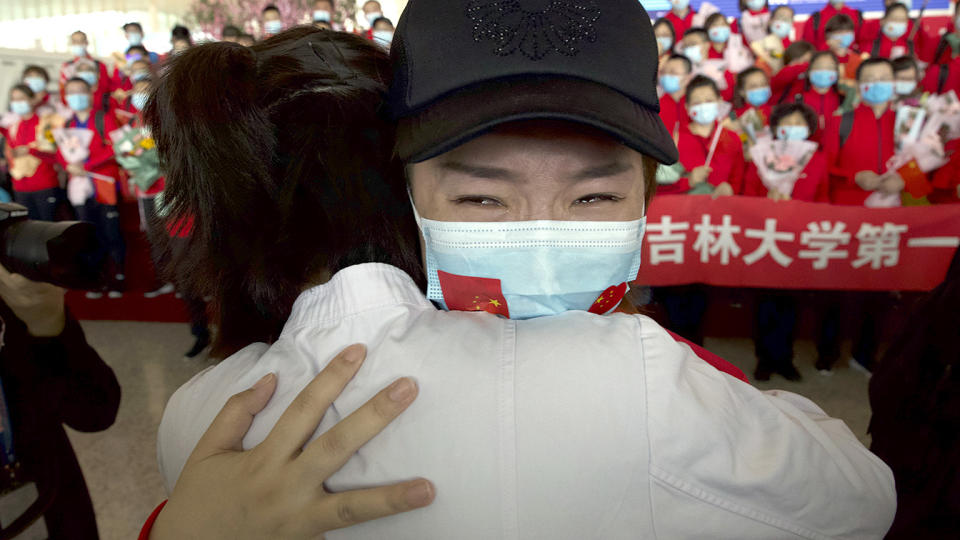Wuhan is open and infections are down, but China's coronavirus numbers can't be trusted
China this week officially reopened Wuhan, the city where the coronavirus pandemic was first detected, claiming that new infections were in the single digits. Some have hailed the seeming success of China’s draconian lockdown as a model for other countries.
In recent days, however, everyone from the CIA to Chinese investigative journalists has accused Beijing of reporting inaccurate counts of COVID-19 cases, hospitalizations and deaths, pointing to patterns in other countries, to frequent unexplained changes in China’s accounting, and even to pallets of urns being delivered to funeral homes in Wuhan.
These concerns are not new, but neither are they an indication of some nefarious plot. Rather, they evince a degree and type of weakness that may surprise some critics abroad, who think the Chinese government effectively controls all aspects of life in the country with an iron fist. In fact, underreporting of bad news is not a simple product of autocratic leaders’ cruel strategy, but an artifact of China’s idiosyncratic authoritarianism that goes back decades, though it has resurfaced acutely over the past 15 years.
In 1958, the People’s Republic of China initiated one of the largest and most radical utopian experiments in human history: the Great Leap Forward. All land and agricultural labor were to be fully collectivized overnight, traditional family units were to be disrupted, and the rural Chinese economy freed of private property. The result was a calamity of monumental proportions. Between 1958 and 1962, more than 30 million people starved to death. Horrific violence (even, in a few cases, cannibalism) erupted, and social order broke down throughout much of the country.

The magnitude of devastation was almost impossible to comprehend — largely because of statistics.
Under extreme pressure to show results, local cadres reported vastly exaggerated yields and harvests. Some areas claimed to be producing more grain, for example, than could possibly be grown even if every square inch of their jurisdictions had been successfully planted. Higher authorities accepted many such reports at face value, eager to see the Great Leap as a success, and requisitioned concomitantly large amounts of grain, much of which rotted in warehouses for want of adequate distribution systems.
More than a year into the carnage, Chairman Mao Zedong lashed out against underlings who raised concerns and eventually had to be pushed aside so that other leaders (many of whom became targets of the Cultural Revolution a few years later) could take charge of cleaning up the disaster.
Four decades later, in 2003, severe acute respiratory syndrome (SARS) ravaged China. The outbreak was made far worse and spread far more widely because doctors and health officials who tried to sound the alarm early on were suppressed. What began as a small cluster of cases in Guangzhou became a major epidemic infecting Hong Kong, Beijing and even Toronto.
President Hu Jintao and other Chinese leaders, chastened by that crisis and how it had spun beyond their control, established an enviable national pandemic early warning network. Local public health authorities were to monitor flare-ups of infectious disease and report quickly to higher levels any worrisome trends or unforeseen spikes in the number of patients seeking care. By all accounts, China ought to have been well positioned to catch and suppress an outbreak of a novel pathogen, particularly a close cousin of SARS like SARS-CoV-2 (the coronavirus pathogen that causes COVID-19).

But it didn’t, and here’s why.
First, large parts of Sichuan, in southwestern China, were devastated by one of the worst earthquakes in modern history on the afternoon of May 12, 2008. The central state quickly took charge in the aftermath, organizing massive programs of paired support, in which wealthier provinces or cities helped rebuild ruined neighborhoods and towns. A few short months after the earthquake, the political tone shifted to one of a “gratitude campaign” showcasing the competence and munificence of the central government and Communist Party leadership as well as the spirit of national unity. A severe setback was leveraged into the ultimate affirmation of the party’s political narrative.
Second, Xi Jinping rose to power as a new type of leader in 2012. Concerned about the party’s eroding power to inspire, he sought to restore a kind of ideological rectitude and political discipline that harkened back to the Maoist era. China in the past eight years has pursued ruthless ongoing campaigns against corruption and in support of “socialist core values,” as well as Xi’s own position as “core leader.” Now nearly every county-level cadre has met Xi in person (likely again since January via teleconference), and many have seen at least one or two of their immediate superiors purged for corruption or ideological errors. This left the apparatus more loyal, but also far more wary, by 2019 than it had been in perhaps 30 years.
When a new coronavirus began wreaking havoc in Wuhan in late 2019, local officials were thus especially leery of reporting the grim news and terrified of any implication that they may not have been handling it properly. Li Wenliang, a young doctor who tried to raise the alarm, was admonished and threatened in a crudely worded letter, given to him by local police after they interrogated him on Jan. 3, 2020. Just a few days later, on Jan. 7, the CCP Politburo Standing Committee met in Beijing to discuss the outbreak. No strong action was taken and no report of the discussion was published. Two weeks later, cases and deaths began to spiral and the country went into lockdown.

When Li died of COVID-19 on Feb. 7, many saw it as a shocking testament to the party’s and President Xi’s failure of leadership. Thousands of online tributes contained strident criticism of how Li had been silenced and the consequences for Chinese society. The CCP’s credibility and legitimacy seemed to suffer a serious blow — until COVID-19’s relatively unchecked spread across Europe, combined with the lifting of China’s most stringent lockdown measures in early March.
At that point, Xi was able to shift the narrative to one that highlighted China’s competence at controlling the virus and ultimately melded into a full-blown “campaign of gratitude” reminiscent of the 2008 earthquake response (right down to its stressing the success of a new round of paired support for Wuhan’s health care services). Of course, in this environment, despite published warnings not to conceal new cases, local officials have even stronger incentives now not to tarnish the leadership’s image by reporting new outbreaks.
It is a chronic pathology of China’s particular brand of authoritarianism that prevents even central officials from believing statistics reported by lower levels, and helps lead time and again to tragedies like the Great Leap Forward or COVID-19. But recent episodes have aggravated the underlying malady. Old habits die hard in China, even as a new virus spreads explosively around the world.
William Hurst is a professor in the Department of Political Science at Northwestern University, focusing mainly on Chinese and Indonesian politics, especially the politics of courts and legal institutions, labor politics, contentious politics, and political economy.

_____
Click here for the latest coronavirus news and updates. According to experts, people over 60 and those who are immunocompromised continue to be the most at risk. If you have questions, please refer to the CDC’s and WHO’s resource guides.
Read more:


